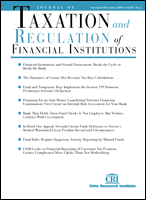Complete Issue
Author: Houman Shadab.
Source: Volume 28, Number 05, May/June 2015 , pp.1-52(52)

< previous article |return to table of contents
Abstract:
In our first article, Lee A. Schneider, Chen Xu, and Gregory J. Lyons discuss regulations intended to stabilize large banks by mandating certain funding requirements. The authors focus on the Basel Committee on Banking Supervision’s liquidity coverage and net stable funding ratios, how they are being implemented by U.S. financial regulators, their impact on brokerdealers, and the interplay between the rules. As the authors note, the rules will have important implications for compliance and supporting technology. In our second article, Lynn E. Fowler and Heather Preston examine why investment fund investors do not make greater use of target allocations to provide themselves with certainty when it comes to payments. As the authors explain, using a partnership tax allocation method that does not rely on the traditional partnership safe harbors, which are based on having a substantial economic effect, or the partners’ interest, runs certain risks. These risks include whether the Internal Revenue Service (IRS) will respect a partnership’s allocation of nonrecourse deductions and its treatment of a distributive share. Michael A. Krajcer, in our third article, explains the recently proposed IRS regulations that favor software development by providing a tax credit. This proposed credit is of particular interest to financial institutions given their increasing reliance on software purchases from third-party vendors. As Mr. Krajcer notes, the proposed rules operate by revising the definition of internal-use software to exclude interactive third-party software from being required to meet additional hurdles to qualify for the tax credit. Private investment funds typically compensate their investment advisers with a management fee and a carried interest fee based on the fund’s profits. In our next article, Matthew T. Szudajski discusses the possibility that the IRS will recharacterize an investment adviser’s fees based on fund profits. Mr. Szudajski explains how, in order to protect pass-through capital gain treatment, the adviser must bear direct downside risk in some form, such as through a loss allocation, income offset, or income clawback. Kelley A. Howes, in our Regulation column, discusses a novel 2014 action brought by the Securities and Exchange Commission (SEC) against a venture capital adviser pursuant to the “pay-to-play” rule of the Investment Advisers Act of 1940. The SEC charged the adviser with violating the rule because an associate of the adviser made campaign contributions to the governor of Pennsylvania and a Philadelphia mayoral candidate within two years prior to the fund receiving compensation from two Pennsylvania state employee pension funds. Our issue concludes with a State & Local column by John P. Barrie about the March 2015 Supreme Court opinion in Direct Marketing Association v. Brohl, which held that the federal Tax Injunction Act did not prevent a legal challenge to Colorado laws imposing tax reporting requirements on out-of-state retailers. In addition to bolstering the strength of financial institutions challenging state tax reporting requirements, Mr. Barrie notes that the decision may also be relevant to the pending Florida Bankers Association v. Department of Treasury case, in which reporting requirements under the Foreign Account Tax Compliance Act are being challenged as unduly burdensome.Keywords: Basel Committee liquidity requirements; Target allocation in investment funds; Research and development tax credit eligibility for financial institutions; Partnership tax redeterminations; Pay-to-play laws; State and Local Tax Collections by Out-of-S
Affiliations:
1: New York Law School.